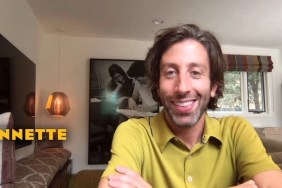Lee Gambin bites deep into J.P. Simon’s exploitation classic Slugs
In 1988, an incredibly effective and successfully structured remake of a fifties teen-centric horror classic was released, providing gore-hungry audiences some startling grotesque imagery in its depiction of a fictional small Californian town being devoured by an acidic amoebic entity. The film was Chuck Russell’s The Blob, which boasted unapologetic excesses in visceral blood-drenched (as well as exceedingly highly creative) death sequences akin to the on-screen violence that dominated the earlier part of the decade. Released the same year, was a film that actively tipped its hat to the original Steve McQueen vehicle from 1958 and the aforementioned inventive “re-imagining” – the gritty, no-nonsense, equally graphic ecologically bent horror film Slugs, directed by Juan Piquer Simon – the infamous Spanish director who also delivered the cult favorite Pieces (1982).
Based on Shaun Hutson’s novel of the same name, Slugs shares the concept of a sleepy halcyon small town being consumed by a monstrous force with multiple citizens both permitted varying degrees of subplot as well as a gruesome demise – and that is the basis for both variants of The Blob; that townsfolk are slowly, one by one, disbursed by a menace that washes away the last remains of idyllic untroubled America. However, because Slugs falls into the eco-horror film realm – a subgenre that heavily relies on the imbalance of the natural order and the strained relationship between humankind and the environment, and a subgenre sometimes instinctively dependent on narrative and character fixtures that are distinctly unique to the natural horror film – Slugs also sets up formally conceived tropes calculatedly used and represented by the personality types that pepper the film.
RELATED: Slugs Blu-ray reviewed
Slugs automatically establishes it’s pre-titles sequence by utilizing the “teen lovers in jeopardy” trope, which is something seen in classic eco-horror fare such as Joe Dante’s sophisticated Piranha (1978), and even seen in the significantly iconic “death of Chrissie” sequence in Steven Spielberg’s Jaws (1975). Even from this curtain raiser, Simon’s film is essentially a check-list of eco-horror movie trappings that swiftly work and function in apropos fashion. The film employs the smart and attractive sympathetic professional in the female lead (a teacher unfairly disliked by her students), the cold and unfeeling opportunistic industrialists (who are of course part of the problem at hand), the “ostrich with his head in the sand” authority figure (represented by an oafish sheriff), the oversexed nymphette and slacker counterpart (who get a nasty death scene complete with gratuitous nudity), the soon-to-be perplexed scientist (who has to deliver the yawn-inducing blah blah about the genetics and so forth of terrestrial gastropod molluscs) and the essential hero who is forced to take matters in his own hands and outside of the system.

Slugs is a film that thoroughly banks on formulaic ingredients, and for that, it should be championed and not ever thought of as lazy or uninspired. This is a work that demands the controlled heavy hand of character mainstays who are systematically manipulated by the robust and firmly grounded script which is presented in a relatively blunt, bleak, direct and somewhat subdued fashion.
The film dances with an intentional microcosm of sociological disarray as well as a contemplative view on class resentment and economic insecurity. One of the earliest deaths in the film concerns a disheveled alcoholic elderly man facing eviction, and after the unfortunate blue collar slaying, director Simon cuts to the stiffness and pretentiousness of yuppie culture. This is the underplayed subversive nature of the film, which both happily presents a glaring unadorned account of bloodthirsty slugs in exploitation cinema terrain, and also makes cagey commentary on industry versus progressive thinking and the righteous. The film is invested in the ethos of repugnant yuppiedom and even with its stark aesthetic, the film manages to play up the distinction between those “who live well” and those who “get by”. The hero of the piece is thrust in the middle of both worlds, and this is another additive that makes Slugs a more complicated work than what it seems.

Mike Brady (an almost laughable name seeing that it sets pop-culture vulture minds winding back to Robert Reed’s patriarchal figure head in that polyester-riddled sitcom) is an urbane “left over cowboy” played with a stoic straight face by Michael Garfield (an actor whose credit before this simply includes the gang warfare masterpiece The Warriors (1979)). Unlike Robert Forster in Alligator (1980) or Bradford Dillman in Piranha, Garfield’s Brady is not hung up by past trauma, nor is he a working class hero, but he is a well-to-do health inspector who seems to be the go-to task force as opposed to the impotent police force who remain in a state of perpetual disbelief when the plot concerns killer slugs.
Stippled with director Simon’s somewhat trademark insane dialogue and even more so crazy methods of delivery from his cast (horror aficionados will forever laud the screaming of “Baaaaaastaaaaaaaards!” from Linda Day George in his splatter opus Pieces), the film relentlessly offers bizarre histrionics from the energetic performers which gives Slugs a unique flair and nonchalant (and almost ruthless) “up yours” to taste makers everywhere. The film is an enjoyable and perpetually fun ride and if it works as a tribute, then it does so successfully. It showcases such sensibility in a scene involving the teen cast who congregate at an updated “hub” to a soundtrack popping with a fifties aesthete which plays with the fact that Simon is possibly summoning the ancestral ghost of Cold War anxiety in the shape of The Blob. While the teenagers in the film and their subplots aren’t at all captivating (nor are they really necessary), they do serve as excellent fodder for a swarm of monstrous slugs hungry for young, healthy human flesh. While elderly bickering greenhouse keepers cop some gruesome attacks, it is the teenage cast that cop it in severity.

The scene where sexpot Donna (Kari Rose) is ripped to shreds by slugs is a celebration of violent excessiveness that was welcomed by gorehounds of the eighties hungry for graphic, expressive and relentless depictions of mass mutilation and creatively staged and constructed bloodbaths. This is the primitive gut churning centerpiece of the film, and also a masterfully concocted image of “girl in peril tortured and slaughtered by the film’s featured monster”. Effective in its nastiness and gleefully macabre, the sequence rings similar to a film released the year earlier – the portmanteau par excellence Creepshow 2 (1987). In this follow up to George A. Romero’s superlative original anthology monster show from 1982, a story entitled “The Raft” features an impressive incident involving a young girl’s flesh being torn off by a river dwelling ooze very similar to the all-consuming Blob.
With the puppet slugs used to evoke a sense of cartoonish buffoonery and a tongue in cheek sense of fun, the film refuses to tip into comic territory for too long. There is a necessary weight to Slugs, as it is fundamentally about a town consumed by bloodthirsty creatures affected by radioactive pollutants. Much like Lewis Teague’s socially aware and politically biting Alligator, the featured monster is essentially a by-product of human negligence (as well as being sewer dwelling) and as much as Slugs is not nearly as concentrated, intelligent or masterfully constructed as Jeff Lieberman’s Squirm (1976), it does bear that similar semblance to the fact that an entire community is being eaten alive. Complacency and apathy lead to a slimy demise in Slugs, while pro-activity and determined questioning of authoritative institutions such as government, law and state prove to catapult survival.
The scientist in Slugs and his mind-bogglingly dull exposition about such critters is mandatory banter that ensures us there are characters invested in the study of such creatures. In regards to carnivorous minuscule beasties, he notes: “…there are some species that do it – tiny worms, insects…” and this is made all the more reasonable when we are then bombarded with continual scepticism from the powers that be. “What will it be next? Demented crickets?” an agitated sheriff exclaims – and this throwaway comic line is unintentionally loaded in that it makes a snappy commentary on the long laundry list of animal-centric horror where everything from grasshoppers (Beginning of the End (1957)) to bunny rabbits (Night of the Lepus (1972)) have caused panic for the human race throughout cinema history. Slugs is a cacophony of deranged amusing entertainment and all the elements contort themselves in an adequate manner to serve this cinematic insanity.

The score is bombastic and sometimes completely displaced as it plays out (especially in the latter part of the movie) with an overstated sense of urgency – sometimes good (when reigned in and used methodically) but for the most part utterly insane. But this is a mechanism that serves the bipolar nature of the film; it is as if the score counters the dialogue which pops with unintentional hilarity and off the wall maniacal melodramatics. But as aforementioned, the film is not entirely a comic book no-brainer; it has important subliminal interests in its very fabric.
Slugs marries popular culture with exploitation, for example, providing some fun commentary on vegetarianism which was becoming an increasingly popular diet choice in the eighties, with the environmental movement in full mainstream attention. Yuppie slime David (Emilio Linder) swallows a slug in his salad (a healthy alternative to steak prepared by his boozy lover), which comes back to torment him at an important business dinner. Once again, the film’s carefully unobtrusive interest in cold and banal corporation and the concept of commerce over health and safety come into full swing, and the violent blood spurting and eyeball socket popping restaurant scene is just as visually outstanding as Donna’s hideous demise. The film’s strongest element is the wonderfully operatic and grimy gore – the film revels in excessive bloodshed and grotesque imagery which compliments the secretive social agenda, and for this reason alone, the film is a successful addition to highly visceral eighties horror.
Ecological horror during the eighties was far more character driven, and not too concerned with the global repercussions of an environment in decay. Instead, the eco-horror film of the eighties “bought the beast home” and used the interplay between crazed animal or insect with human suffrage or struggle as the thematic pressure point. Savage Harvest (1981) juxtaposed familial melodramatics with lion attacks, Cujo (1983) dealt with domestic unrest and the perils of adultery, Monkey Shines (1988) was acutely invested in the role of dependency and unwholesome desire and so forth, rendering the seventies natural horror film (the decade that truly defined it and boasted the most popular) as a political and/or sociological response to environmental crisis. Here, in Slugs (a film made during the time of the personal enviro-creature feature) the efforts made to hearken back to a universal problem that sang out its issues and concerns so boldly during the decade earlier, is most certainly the case. There is not much time spent on interpersonal relations shared between characters who are ultimately painted up in broad colors, instead the film takes on it’s thematic core with a look at societal distortion, classicism and economic irresponsibility.
The world of commerce and industry against the underdog sole believer of the truth sits at the principal heart of the film, and a Halloween party comes to be the centerpiece for the final act where horny teens are devoured by hungry slimy slugs. Climaxing with explosive action sequences where our hero and his help take on the nasty pests, Slugs contains lines such as “Back in the fifties and sixties…this place was a toxic waste dump” notably tipping the hat to drive-in monster movies of the time. The unapologetic gratuitousness and gaudiness of this Spanish production is a testament to elementally carnal and explicit filmmaking from non-English speaking nations. Although the source material is that of an English novel by horror scribe Shaun Hutson – profiled by prolific and well respected critic Chas Balun for Fangoria magazine during the eighties – the film revels in the sleazy and lascivious. All in all, Slugs is a sickening, slithering fun ride for splatter fans with an appetite for gut spillage and facial con-caving! Enjoy!









